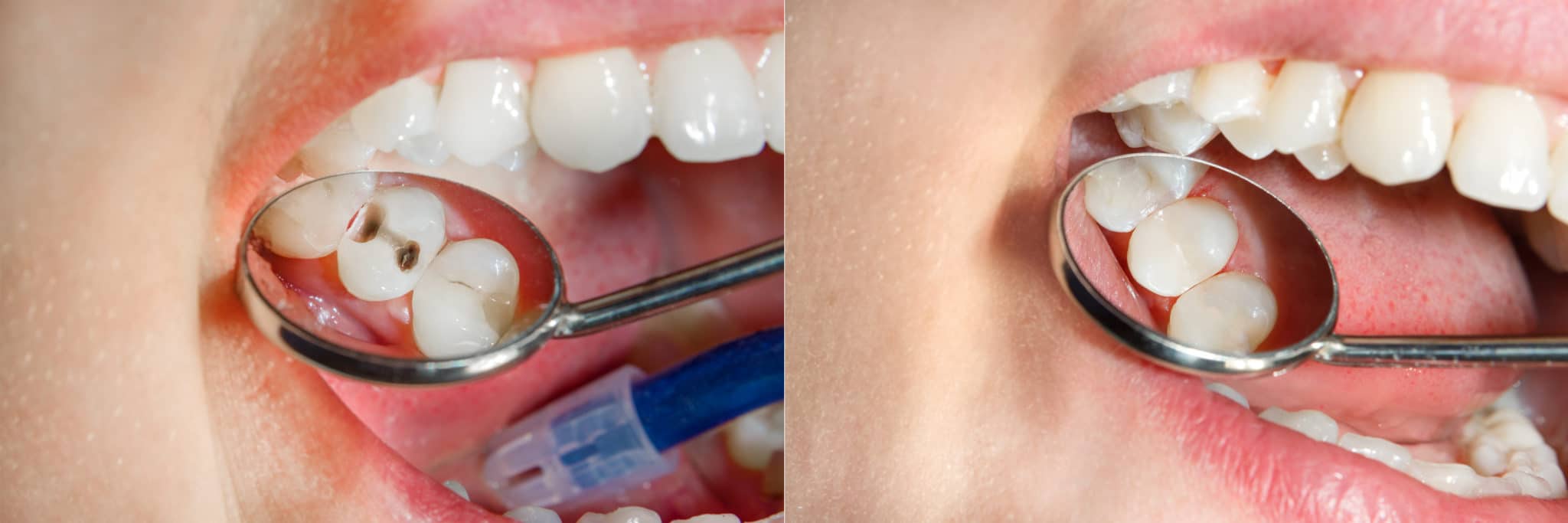If you’ve ever wondered, can you reverse a cavity or how to remineralize teeth, you’re one of many. Studies show that tooth decay is one of the most common diseases. In fact, 90% of adults age 20-64 have had dental caries in their lifetime. And approximately 1 in 4 have decay which is actively untreated.
But does having a cavity mean you definitely need dental work? In this article, we’ll discuss the concept of tooth decay, we’ll talk about how to remineralize teeth, and answer the question…can you reverse a cavity.
What is a Cavity

A cavity is what is medically known as dental decay or caries. And it is just as it sounds. It’s a hole in the surface of the tooth.
But there’s a bit more to it than that. The important thing to realize is that dental decay is progressive if it is not controlled. Once a cavity forms on a tooth, it creates a defect in the tooth which becomes progressively deepened. The cavity becomes progressively more difficult to clean.
Bacteria begin to reside in the cavity and continue to breakdown more of the tooth. They do so by producing an acid which is a byproduct of their metabolism—more on that later.
What I want you to understand is that dental decay progressively destroys tooth structure. This happens by a process called demineralization. Demineralization of teeth is exactly as it seems. The minerals of the tooth begin to break down and decay into a soften, diseased structure.
Can You Reverse a Cavity
Tooth demineralization is not a continuous and unidirectional process. It is a process which can cycle between periods of demineralization and remineralization. The structure of tooth enamel is made of minerals which are organized in a lattice called hydroxyapatite.
So if you’re asking, can you reverse a cavity, then the answer is…Yes.
But with one caveat. A tooth can remineralize only when a cavity is small.
Let’s discuss.
A dental cavity occurs when a process occurs which begins to remove minerals from the surface of the tooth. Just like we talked about above…that’s called demineralization. It occurs due to acid which sits on the teeth for a period of time.
The acid can be derived from acidic foods/beverages or can be produced by bacteria which reside on the teeth. Thus, demineralization is caused by acid which changes the pH of the surface of the tooth.
Now lets talk about how remineralization of teeth works.
The remineralization process is a natural repair mechanism to restore the minerals again. Now here is the caveat. It can occur only in the early stages of a cavity forming. Dental caries is a progressive process and there is limited time for remineralization. Once a cavity reaches past the initial surface of the tooth, remineralization cannot recreate large amounts of tooth structure once it is lost.
The key for remineralization to occurs is creating an environment where the tooth surface is basic or near-neutral pH. At neutral pH, calcium and phosphate mineral ions are redeposited within the caries lesion from saliva which results in the formation of new minerals to form in the lattice of the enamel.
So is there a way how to remineralize teeth by doing things to help the process? Turns out there are. It comes down to your daily lifestyle and habits. Let’s look at some daily habits of how to remineralize teeth in the next section.
Top Seven Ways How to Remineralize Teeth
Stay hydrated
By hydrating you are increasing your body’s ability to produce saliva which contains essential minerals to aid remineralization of tooth enamel and saliva also serves as a buffer for acid on the teeth.
Reduce foods that have sugar
The bacteria which live in humans’ mouths utilize the sugars we consume to produce an acidic by product. By reducing sugars in your diet, the bacteria have less sugar available to metabolize and therefore bath the teeth in less acid which limits demineralization.
Eat foods that are basic pH
Foods such as cheese, vegetables, and nuts have neutral to basic pH and help to neutralize the pH of the surface of the teeth.
Reduce foods that are acidic
Foods such as soda, energy drinks, and citric fruits have an acidic pH. It can be deceiving since many of these items taste sweet, but yet they are actually acidic. Try to limit acidic foods which have a tendency to erode and demineralize enamel over time.
Use fluoridated toothpaste
Fluoride has been shown to bind the surface of the tooth. It serves two benefits. It limits bacteria’s ability to produce an acidic byproduct from their metabolism. Fluoride ions also bind to the surface of the tooth and remineralize the tooth by incorporating the fluoride ions into the hydroxyapatite lattice of enamel. For remineralization, fluoride toothpaste is a must.
Rinse After Eating
Rinsing is a pretty easy technique to help reverse a cavity and a simple method of how to remineralize teeth. If you think about it, it’s simply a wash cycle for your teeth. Say you had an acidic beverage or a sugary snack, rinsing with water helps to wash away the substances which otherwise would sit on your teeth and prevent remineralization.
Chew Gum
Similar to the concept of rinsing, chewing gum helps to mechanically rid the teeth of plaque, food, and substances that may be sticking on the surface of the teeth. Chew gum to help reverse a cavity…but not just any gum. Stick to sugar-free gums that contain Xylitol that works to fight plaque, kill cavity-causing bacteria and encourage your saliva natural production.
So if I Can Remineralize my Teeth- Why does My Dentist Want to Do a Filling?

The issue with tooth decay is that once it reaches a certain point, fluoride and minerals cannot reach the area that needs to be remineralized.
It’s too deep.
The decay is essentially trapped in the tooth left to progress deeper. That’s why a dentist recommends a filling. The cavity is too deep to remineralize at that point.
Although correcting decay with a filling may seem disappointing to you, it’s the better option between two evils. Having a dental filling prevents the progression of the decay which could eventually cause pain, more tooth enamel loss, an abscess, or more complex procedures like a dental crown, root canal, or god forbid…an extraction.
Wrapping Up: Can you Reverse a Cavity
To summarize, yes you can reverse a cavity, but only when a cavity is early in the process. Early is defined as less than halfway into the enamel.
There are ways how to remineralize teeth and just like all habits of a healthy lifestyle…they require consistency over a long period of time for best results.


